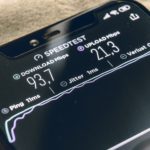In 2018, mobile broadband providers began to roll out 5G networks to large population centers throughout the U.S., following limited deployments in 2017. 5G is available in New York City,…
5G is a developing standard and a set of technologies that include MIMO, the use of the millimeter wave spectrum, small cell technology, and improved network management techniques. Together, they create a wireless network with substantially improved reliability, operational efficiency, and latency.
Millimeter wave bandwidth has a reduced geographic range compared to areas of the spectrum traditionally used for wireless communications, but recent advances in area coverage have made deploying millimeter wave networks more practical. And, of course, millimeter wave compensates with bandwidth increases of an order of magnitude compared to 4G.
Alongside massive MIMO (multiple input, multiple output) which equips transmitter/receiver stations with dozens of antennae, the millimeter wave spectrum offers massive increases in data throughput, energy efficiency, and the number of devices that can be connected at any one time in an area.
We can expect to see theoretical data throughput of between 1 Gbps and 10 Gbps. Users are likely to see lower throughput in real-world applications, but the performance will outstrip existing wireless technologies by a wide margin and offer performance that exceeds that of the wired broadband available in many areas of the US.
5G bandwidth will be more than sufficient to stream high-definition media to mobile devices and will have an impact on the feasibility of immersive augmented and virtual reality applications. VR and AR are bandwidth intensive, limiting their usefulness for mobile devices, wearables, and in automotive technology. According to Qualcomm: “The AR and VR industry is thirsty for the capabilities 5G promises.”
Perhaps of even greater importance is reduced latency. The latency of mobile connectivity has long been a barrier to real-time communications. The Internet of Things will benefit enormously from the radically improved latencies and energy efficiencies that 5G networks can deliver.
Over the next few years, we can expect millions of low-power, always connected devices to be deployed. Smart sensor-equipped devices will be able to communicate with data centers and with each other over mesh networks in real time. Lower latencies will bring advances in fields as varied as self-driving transport and healthcare.
Latency is a big problem for self-driving vehicles. A benefit of self-driving vehicles will be their ability to communicate with other vehicles and with centralized traffic-flow management systems. Cooperative traffic management will improve traffic flow and make our roads more efficient. Latencies between vehicles and traffic management systems are a huge stumbling block — no one wants to be in a traffic accident because their vehicle didn’t receive critical information quickly enough.
Health tracking technology and wearables have seen significant market penetration in recent years, but such devices are limited by their power consumption requirements and the latencies of existing mobile networks. With 5G, some in the healthcare field envision always-connected embedded sensors with real-time connectivity and battery lives measured in years.
It’s expected that 5G will be widely available around 2020. Businesses should be investigating 5G from two different perspectives: its potential to improve business and operational efficiencies, and its potential to create new markets for devices, applications, and services.




